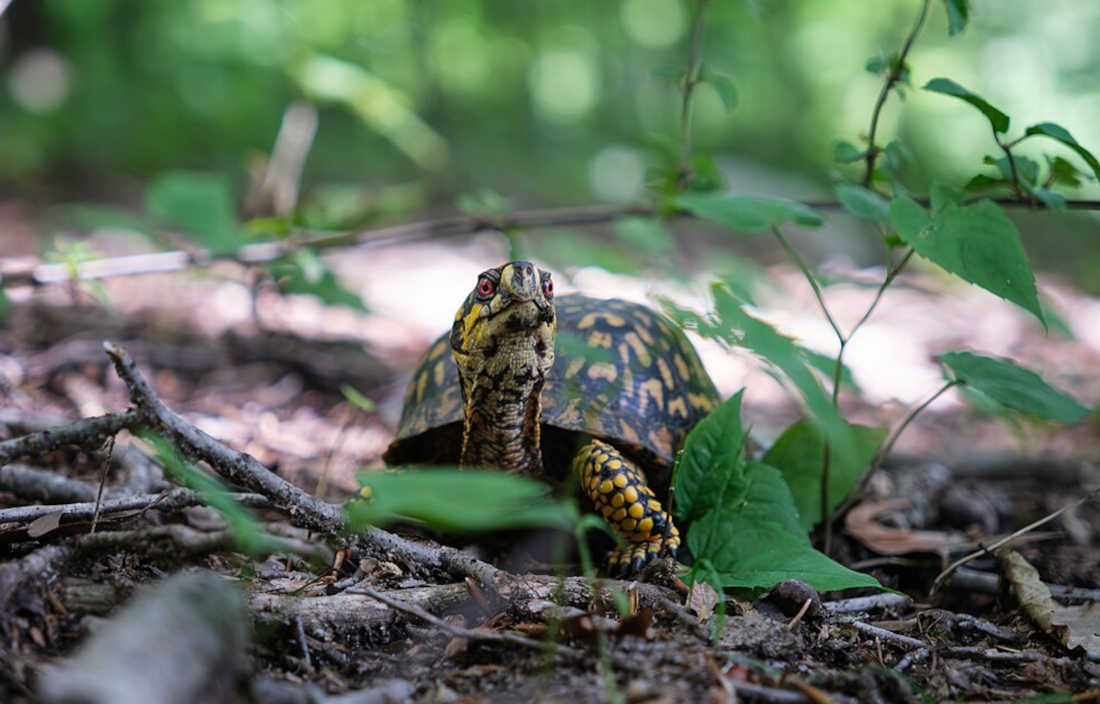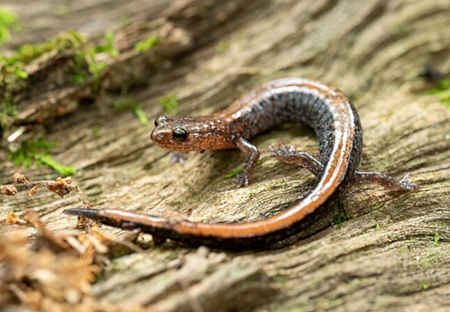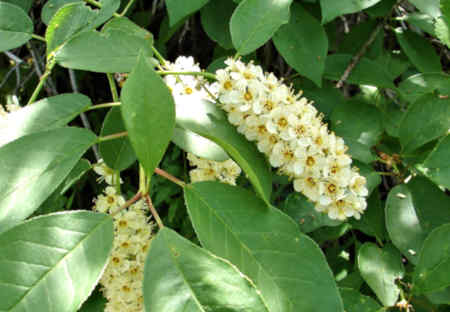Eastern Box Turtle
Eastern Box Turtle: A Shelled Icon of Eastern Woodlands
Fast Facts
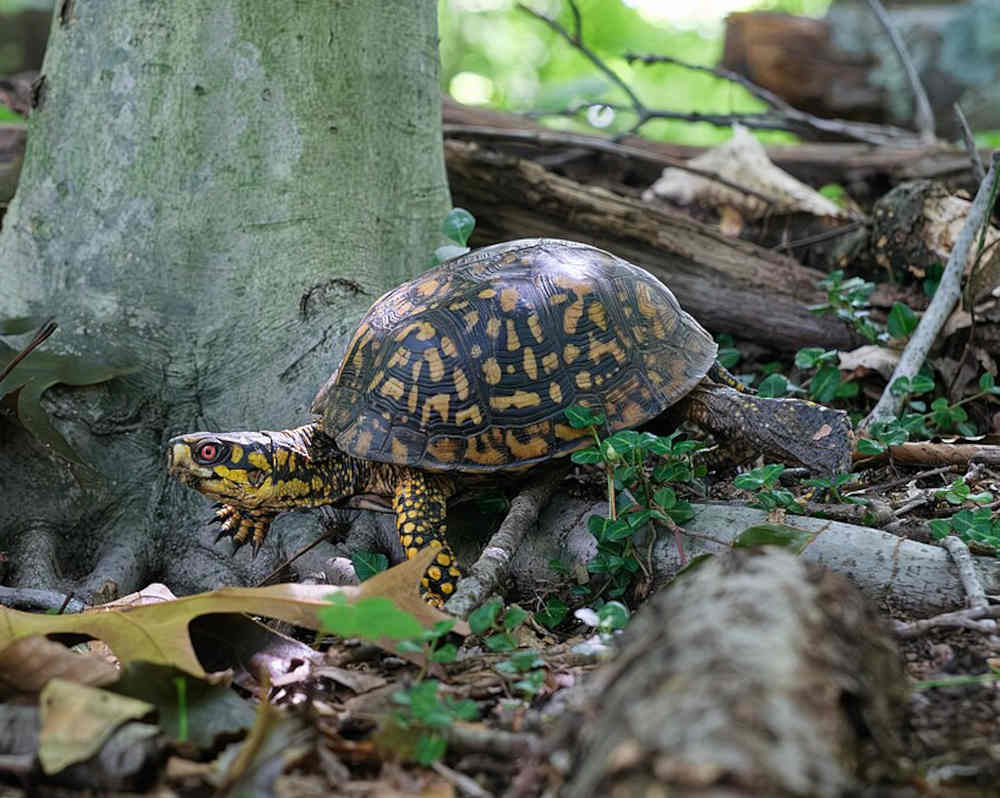
Eastern Box Turtle
Scientific Name: Terrapene carolina carolina
Family: Emydidae (pond and box turtles)
Size: 4.5–6 inches (11–15 cm) in length
Lifespan: 30–50 years on average, but some have been reported to live over 100 years
Range: Eastern United States, from southern Maine to Florida and west to the Great Lakes and parts of Texas
Habitat: Deciduous forests, meadows, and wetlands with loose, moist soil
Diet: Omnivorous—feeds on insects, worms, fungi, berries, mushrooms, and small vertebrates
Reproduction: Lays 3–8 eggs in a shallow nest, with hatchlings emerging in late summer to early fall
Defense Mechanism: Can fully close its hinged shell for protection
Hibernation: Burrows into loose soil or leaf litter during cold months
Threats: Habitat loss, road mortality, illegal collection for the pet trade
Conservation Status: Declining due to habitat destruction and human activity
How to Support Eastern Box Turtles:Maintain natural forested areas, avoid using pesticides, and help turtles cross roads safely in the direction they are heading.
Fun facts: Eastern Box Turtles have unique shell patterns that are like fingerprints—no two are exactly alike!
Eastern Box Turtle: A Shelled Icon of Eastern Woodlands
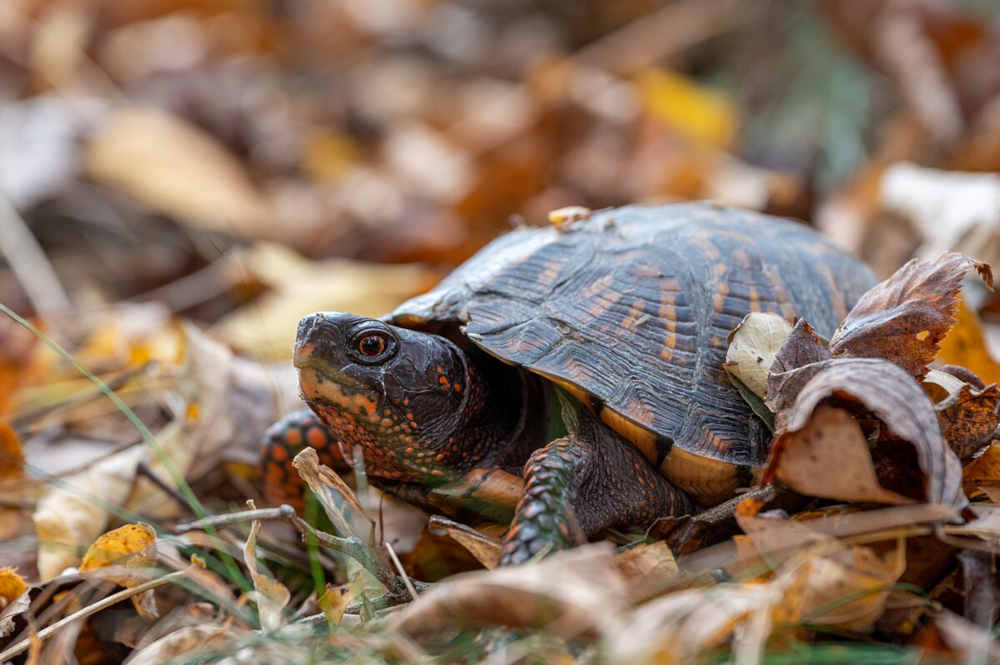
An eastern box turtle in it's native habitat
Introduction
The Eastern Box Turtle is one of the most recognizable and beloved reptiles of eastern North America. Unlike aquatic turtles, these slow-moving land dwellers prefer moist forests and meadows, where they forage for a varied diet of insects, fungi, and fruit. Their domed shells, adorned with intricate yellow or orange patterns, provide excellent camouflage among leaf litter.
Eastern Box Turtles are incredibly long-lived, with some individuals surpassing a century in age. However, their populations are declining due to habitat fragmentation and destruction, road mortality, and illegal collection for the pet trade. As a result, conservation efforts are necessary to protect these unique reptiles.
Eastern Box Turtles are part of a broader trend of reptile population declines worldwide. Habitat destruction, climate change, and human interference have negatively impacted many reptile species, making conservation efforts increasingly urgent.
Description
Eastern Box Turtles (Terrapene carolina carolina) have a highly domed shell that varies in color from dark brown to black, adorned with yellow or orange markings. Their skin is similarly patterned, with males often displaying brighter coloration than females. Males typically have red or orange eyes, while females have brown or yellowish eyes. Males also have a concave plastron (bottom shell) to assist in mating, whereas females have a flat or slightly convex plastron. Their strong, clawed feet allow them to navigate through leaf litter and burrow into soil and mud during dry spells and winter.
Other Subspecies of the Common Box Turtle
Gulf Coast Box Turtle (Terrapene carolina major) - The largest subspecies, found along the Gulf Coast from Florida to Texas. It prefers humid, swampy forests and wetlands, staying near water. Its shell is dark and high-domed with faint markings.
Three-toed Box Turtle (Terrapene carolina triunguis) - Found in the central U.S. (Missouri, Arkansas, Louisiana, Texas, and Oklahoma), it inhabits woodlands and grasslands. It typically has an olive-brown shell with subtle markings and three toes on each hind foot.
Florida Box Turtle (Terrapene carolina bauri) - Endemic to Florida and southern Georgia, it lives in pine flatwoods, hammocks, and coastal areas. It has a dark shell with bright yellow streaks and is more active in warm temperatures.
Range and Habitat
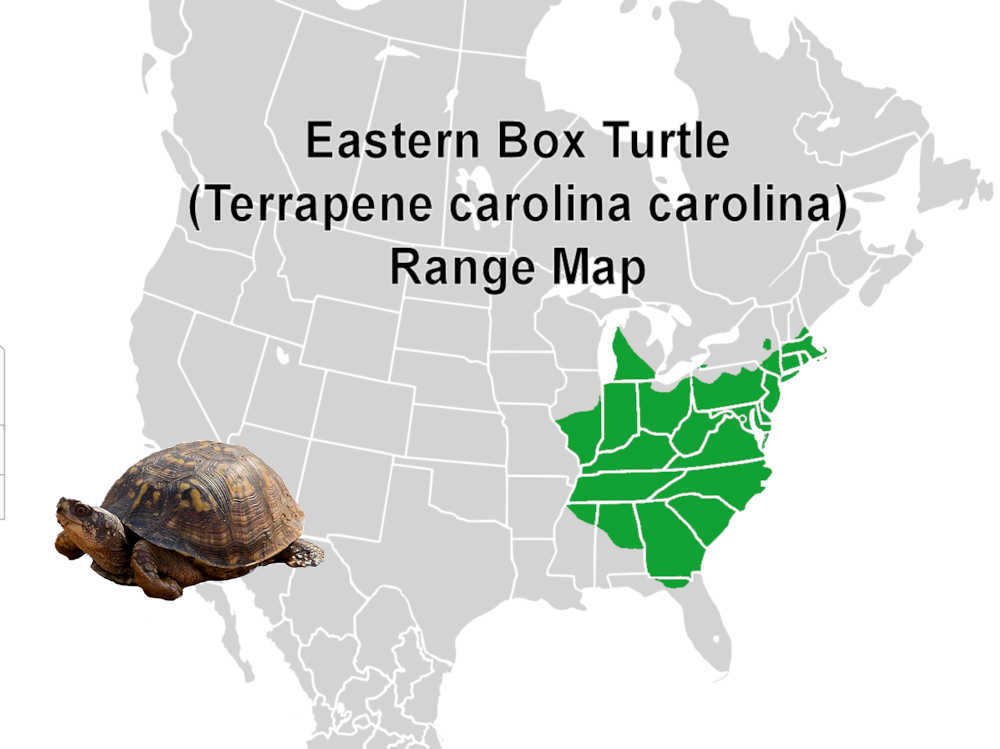
Range Map of the Eastern Box Turtle - Terrapene carolina carolina.
Eastern Box Turtles are found throughout the eastern United States, inhabiting a wide range of forested and semi-open landscapes. They thrive in moist woodlands, floodplains, and meadows with ample leaf litter and loose soil for burrowing.
The other sub-species are found south and west of the Eastern Box Turtle range.
Despite their adaptability, they are highly sensitive to habitat fragmentation. Roads, agriculture, and urban expansion have significantly reduced thier populations. Unlike aquatic turtles, they rely on damp forest floors rather than ponds or streams, though they may occasionally soak in shallow water to stay hydrated and cool.
Diet and Foraging Behavior
Eastern Box Turtles are omnivorous, consuming a diverse range of foods. They feed on earthworms, slugs, beetles, berries, mushrooms, and even carrion. Their diet shifts with age — young turtles tend to eat more protein-rich foods like insects, while adults consume more plant material.
Box turtles play an important role in forest ecosystems by dispersing seeds through their droppings, particularly those of native berries, fungi, and mayapples. They are one of the primary dispersers of mayapple seeds, as the fruit is one of their favored foods. By consuming the fruit and excreting the seeds in new locations, they help maintain and spread mayapple populations, which in turn provide valuable ground cover and habitat for other forest species.
Reproduction and Life Cycle
Mating occurs in the spring and fall, with females laying 3–8 eggs in a shallow, sunlit nest. Unlike many reptiles, Eastern Box Turtles do not guard their nests, leaving hatchlings to fend for themselves upon emergence in late summer or early fall.
Their nests are small, bowl-shaped depressions dug in loose soil, often near forest edges or in open clearings where warmth can aid incubation. These nests face numerous threats, including predation from raccoons, skunks, and birds, as well as human disturbances. In suburban areas, dogs often dig up nests. As development increases, fewer safe nesting sites remain, making reproduction even more challenging.
Temperature determines the sex of the hatchlings—warmer nest temperatures favor females, while cooler temperatures favor males. Hatchlings are particularly vulnerable to predators, contributing to high mortality rates in the early stages of life.
Hibernation and Seasonal Behavior
As cold weather approaches, Eastern Box Turtles enter brumation (a hibernation-like state) by burrowing into loose soil or leaf litter. They remain dormant throughout winter, emerging in spring when temperatures rise.
Unlike aquatic turtles, which overwinter in water, box turtles dig shallow holes to hibernate in and depend on insulating forest floor debris to survive the cold.
Conservation and Threats
Eastern Box Turtle populations are declining due to habitat destruction, road mortality, and illegal collection for the pet trade. Many turtles fail to survive when relocated because they have strong homing instincts, often traveling long distances to return to their original habitat.
Their slow reproductive rate makes it difficult for populations to recover from losses. Since turtles take years to reach maturity and lay relatively few eggs, even small disruptions can have long-term effects on their survival. Habitat fragmentation, particularly from suburban expansion, has trapped many turtles in isolated patches of land where they struggle to find mates. As a result, these populations are aging without reproducing, leading to a slow decline over time.
Eastern Box Turtles also play an important role in seed dispersal for native plants like the mayapple. The loss of native plant diversity due to habitat destruction and competition from invasive species further reduces their foraging resources and disrupts their ecological niche. Many once-thriving mayapple populations have dwindled as invasive plants overtake forests, straining box turtle survival.
Eastern Box Turtles are part of a broader trend of reptile population declines worldwide. Habitat destruction, climate change, and human interference have negatively impacted many reptile species, making conservation efforts increasingly urgent.
How to Support Eastern Box Turtles
Protect Natural Habitats: Preserve wooded areas, meadows, and wetlands to provide shelter and foraging grounds.
Avoid Pesticides and Herbicides: These chemicals can harm turtles and reduce their food sources, including native plants.
Help Turtles Cross Roads Safely: If you find a turtle on the road, move it to the other side in the direction it was heading.
Keep Wild Turtles Wild: Never take a box turtle from the wild as a pet. Doing so harms both the turtle and the ecosystem.
Create a Turtle-Friendly Yard: If you live near a natural area, leaving leaf litter, logs, and native plants can provide a safe space for box turtles. Planting native vegetation such as mayapples can also support their diet and help sustain the delicate forest ecosystem they rely on.
By taking simple conservation steps, we can help ensure the survival of Eastern Box Turtles for generations to come.
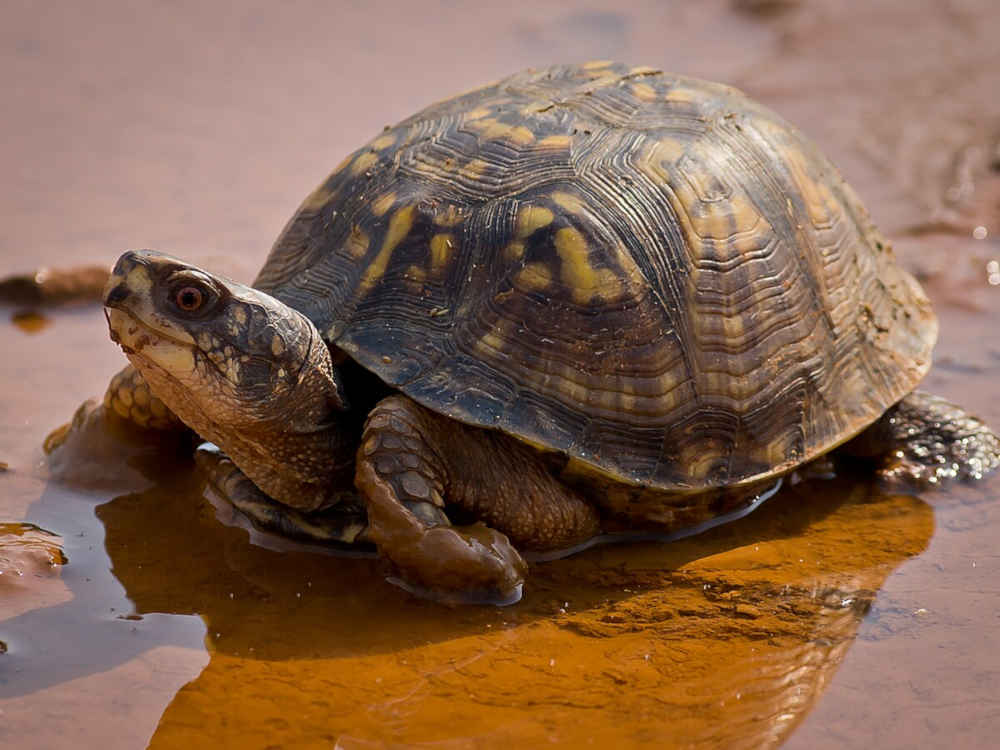
An Easter Box Turtle in a puddle
References
Dodd, C.K. Jr. (2001). North American Box Turtles: A Natural History. University of Oklahoma Press.
Gibbons, J.W., et al. (2000). "The global decline of reptiles, déjà vu amphibians." BioScience, 50(8), 653-666.
Kimmons, J.B., & Moll, D. (2010). "Seed dispersal by Terrapene carolina: Implications for forest regeneration." Herpetological Conservation and Biology, 5(1), 58-63.
Lovich, J.E., Ennen, J.R. (2013). "A quantitative analysis of the state of knowledge of turtles of the United States and Canada." Chelonian Conservation and Biology, 12(2), 227-235.
